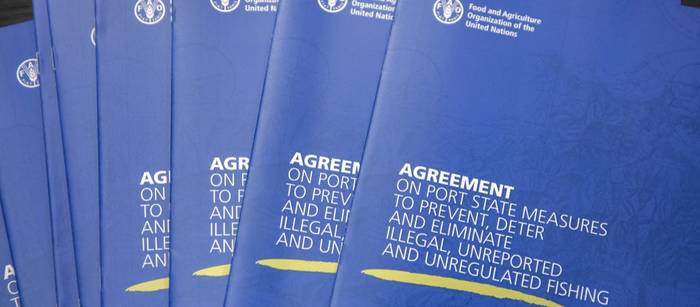History
Early foundation of port State measures in international fisheries instruments
The evolution of the legal foundation for port State measures began with the 1982 United Nations Convention on the Law of the Sea; port State measures are addressed in the 1982 Convention in Article 218, although they relate to marine pollution rather than fisheries-related issues. In the decades following, a number of binding and non-binding fisheries instruments were concluded, in which port State measures, along with IUU fishing, gained increasing coverage and importance, including:
- The 1993 FAO Compliance Agreement;
- The 1995 Code of Conduct for Responsible Fisheries;
- The 1995 UN Fish Stocks Agreement;
- The 2001 FAO International Plan of Action to Prevent, Deter and Eliminate Illegal, Unreported and Unregulated Fishing.
A dedicated instrument for port State measures
Following the entering into force of the FAO Compliance Agreement, the UN Fish Stock Agreement and the adoption of the IPOA-IUU, FAO initiated the work of developing standards for control in fishing ports. In 2005, the FAO Committee on Fisheries (COFI) endorsed the Model Scheme on Port State Measures to Combat IUU Fishing, which recommends minimum standards for PSMs, requiring appropriate implementation at the regional or national level.
From voluntary to binding
At the time of the Model Scheme, it was recognized that the non-binding nature would provide a loophole in the effective implementation of PSMs, and in this way, the Model Scheme served as a departure point for the elaboration of a set of binding port State measures in a step-by-step approach. The 2006 session of the 1995 UN Fish Stocks Agreement Review Conference supported the idea of developing a global, legally binding instrument on port State measures, and proposed that States and RFMOs initiate a process within FAO to do just that.
The process continued, addressing a number of difficult negotiation issues in various expert and technical consultations, and was approved by the FAO Conference in November 2009 under Article XIV of the FAO Constitution.
The first binding instrument targeting IUU fishing enters into force
While the approval of the PSMA was an important milestone, representing years of difficult negotiations and strong efforts on the part of numerous organizations and States, it would remain an Agreement only on paper until it had the needed twenty-five Parties to enter into force. FAO, in collaboration with a number of States championing the PSMA, as well as RFMOs, NGOs and other organizations, embarked on an awareness campaign to promote the benefits of this Agreement. The efforts paid off and in June 2016, the PSMA entered into force with not twenty-five, but thirty Parties.
From Negotiation to Implementation
Following the entry into force of the PSMA, the focus shifted to questions regarding the implementation of the PSMA. There was a need for clarity on which entities would be responsible for which actions. To this end, the first meeting of the Parties was convened, in order to address a number of these issues. The outcomes of this meeting, are available in the meeting report. In brief, this meeting agreed on a number of key issues that would facilitate the implementation of the PSMA in this early phase:
- established the Part 6 Working Group and approved its Terms of Reference;
- agreed to establish an open-ended technical working group on information exchange;
- agreed to meet every 2 years;
- agreed that FAO would host the information exchange mechanism.

- ©FAO/Alessia Pierdomenico / FAO
